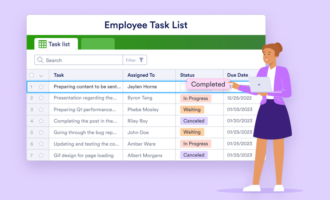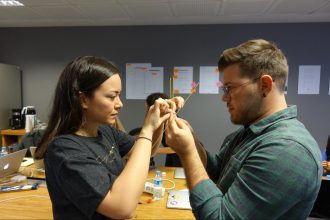Collaboration strategies for the workplace
- Establish goals
- Create a plan
- Set standards and expectations
- Encourage creativity
- Build a culture of knowledge sharing
- Track results and celebrate teamwork
- Create a shared, organized workspace
A strong collaboration strategy cultivates a strong, collaborative team. It’s the blueprint for assigning roles and responsibilities, allocating resources, setting goals, and creating, sharing, and analyzing proposals.
Without a collaboration strategy, your team risks miscommunication, data mismanagement, unnecessary errors, project delays, and, worst of all, falling out of compliance. Ultimately, a solid workplace collaboration strategy is key to success.
An effective collaboration strategy must take into account how team members work together and what each needs to accomplish. While these details change according to team dynamics and the job at hand, there are certain universal collaboration strategies that ensure optimal results. Keep reading to learn what they are and how they work.
1. Establish goals
Goal setting is essential to collaboration. It improves team member engagement, enhances performance, and helps the team stay on track for the future.
When setting collaboration goals, it’s helpful to focus on the desired outcome: What are the objectives and key results the collaboration team would like to achieve? Establishing measurable, metrics-based goals will provide ways to measure the collaboration’s success.
Creating and sharing collaboration goals leads to more accountability from team members, more transparency, and better communication.
2. Create a plan
A collaboration plan is a roadmap for how team members work together. It helps you both identify and prepare for challenges you may experience throughout the project, ultimately leading to a more functional collaboration process that runs smoothly.
Some details that go into a collaboration plan include
- Which team members you need (and from which disciplines)
- What training may be necessary
- Which collaboration technology and tools the team needs
- How to foster effective communication among different team members
- How you plan to lead and manage the team
- How to manage and prevent conflict
- How to allocate budget and resources throughout the collaboration
An effective collaboration plan provides necessary organization and structure. And as the team gains experience and knowledge, collaboration strategies should evolve accordingly.
3. Set standards and expectations
During the planning process, it’s useful to put expectations in writing — along with behavioral standards and best practices.
Some examples of standards and expectations include
- The communal values of the team
- The processes and methods the team should follow
- Expectations about how team members will act toward each other
- The responsibilities of the collaboration team leader
- The impact the work should have on the organization
To ensure everyone understands and meets these standards and expectations, evaluate progress periodically with check-ins and performance updates. When you establish clear expectations, the collaboration team has a clear path forward.
4. Encourage creativity
Creativity in the workplace fuels innovation. To foster creativity among team members, it’s important to establish a culture that allows people to express their ideas freely.
These tips will help you establish a more creative workplace:
- Broaden the perspective. Look at how other teams or even totally different industries do things. It’s possible to find something useful that you can adapt or improve upon.
- Use innovative thinking. Adopt techniques like mind-mapping, brainstorming, and lateral thinking to improve idea creation and creative problem-solving.
- Allow for mistakes. People are more likely to be creative when they know team leaders will allow them to take risks and encourage them to learn from failures.
- Turn ideas into action. When a good idea comes to fruition, everyone involved benefits. Allow team members to explore, test, and refine new approaches.
Most importantly, remember to reward creativity. By establishing an inspiring, open environment — one that encourages helpful, constructive motivation — your team’s best ideas will flow.
5. Build a culture of knowledge sharing
When team members share what they know, it leads to more innovative, creative thinking and better performance.
Here are some ways to foster knowledge sharing in the workplace:
- Create a comfortable space, like a meeting room, for conversation.
- Acknowledge and reward learning — perhaps in the form of a small gift card for completing a webinar or training course.
- Set up social events, like a team happy hour or “lunch-and-learn” program, to plant the seed for learning.
- As the collaboration leader, proactively share experiences with team members.
- Set aside time to discuss challenges and solve problems as a group.
Knowledge sharing helps collaborators bond with each other, sharpen existing skills or learn new ones, and stay motivated to accomplish project goals.
6. Track results and celebrate teamwork
When it comes to getting results, one strategy works above all others: Make success the primary objective. Considering that team members may have conflicting priorities, especially within cross-team collaborations, it’s important to encourage them to place the success of the project above their individual interests.
Celebrating teamwork and focusing on common goals will make all the difference when it comes to reaching milestones and evaluating the success of the project.
There are several ways to evaluate the results of a collaboration. One is by having team members evaluate each other through peer reviews. Another is by bringing in outside team members to gauge the effectiveness of the project.
In the end, however, how well the team meets the business goals as well as the objectives and key results (OKRs) will determine the success of any collaboration.
7. Create a shared, organized workspace
While all of the above collaboration strategies are critical to project success, you need a safe, secure space to put them all into practice where you’re free to set goals, be creative, and celebrate milestones.
If your team works in the same office and can walk down the hall to this shared space, that’s awesome. Enjoy that sacred area and feed off each other’s energy and bright ideas. But, if like many U.S. employers, you have workers spread out remotely across office parks, cities, states, and even countries, you need a different solution.
Enter Jotform Teams, the online workspace that allows you to
- Access, edit, and collaborate on projects
- Automate workflows
- Organize important documents
- Sign, share, and store contracts and proposals
- Convert data into actionable reports
And you can do all of this from one centralized platform. This powerful solution is intuitive, fully customizable, highly secure, and completely code free, ensuring collaborators of all programming backgrounds can contribute, learn, and grow throughout the lifespan of a project.
Best of all, with Jotform Teams, which spans all organization sizes and industries, you’re not limited to one solo workspace. You can build individual online workspaces for each team you oversee — tracking and managing all their assets from one dynamic platform.
Whether you have a team of two people or 200, success is impossible without effective collaboration strategies. These seven strategies can help your teams set and align goals, learn from each other, stay on track, and, ultimately, complete projects they can be proud of.
Photo by Annie Spratt on Unsplash

























Send Comment: